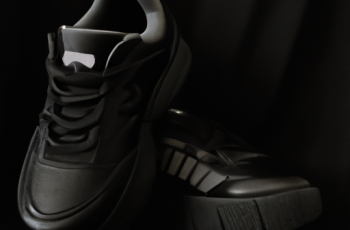Imagine stepping out into the crisp winter air, your feet snugly encased in a pair of knit sneakers. As you walk, you can’t help but marvel at the cozy warmth they provide despite the chilly temperatures. Now imagine the same sneakers accompanying you on a summer adventure, keeping your feet comfortably cool even in the sweltering heat. In this article, we explore the fascinating world of knit sneakers and their unique thermal properties in different climates. From the freezing cold to scorching heat, these sneakers have it all covered. So, get ready to discover the science behind the perfect footwear for every season.

Insulation
Role of insulation in thermal properties
Insulation plays a crucial role in determining the thermal properties of knit sneakers. It refers to the material or technology used to minimize the transfer of heat between the wearer’s foot and the environment. In cold climates, insulation helps to retain the natural body heat generated by the foot, keeping it warm and preventing heat loss. On the other hand, in hot climates, insulation is essential for keeping the foot cool by minimizing heat absorption from the surroundings.
Types of insulation materials used in knit sneakers
Various insulation materials are used in knit sneakers to achieve optimal thermal properties. Synthetic fibers, such as polyester or nylon, are commonly used due to their excellent insulation capabilities and moisture-wicking properties. These materials create a barrier that traps air and prevents heat transfer.
Natural fibers, such as wool or cotton, are also utilized for insulation in knit sneakers. Wool is particularly effective in colder climates, as it provides excellent insulation even when wet. Cotton, while less effective than wool in cold weather, still offers some insulation properties and is more breathable.
In addition to traditional insulation materials, innovative technologies are being incorporated into knit sneakers. These include proprietary synthetic materials engineered to provide enhanced insulation properties, as well as advanced fabric weaving techniques that create tiny air pockets, improving heat retention.
Breathability
Importance of breathability in knit sneakers
Breathability is a vital characteristic of knit sneakers, especially in warmer climates or during intense physical activity. It refers to the sneaker’s ability to allow air circulation around the foot, preventing the accumulation of heat and sweat. Breathability not only enhances comfort but also helps to mitigate foot odor and the risk of skin irritations or fungal infections.
Innovative technologies for enhancing breathability
To ensure optimal breathability, manufacturers incorporate innovative technologies in the design and construction of knit sneakers. One such technology is the use of mesh panels or perforations in the upper material to promote air circulation around the foot. These openings allow heat to escape and fresh air to enter, keeping the foot cool and dry.
Additionally, many knit sneakers utilize moisture-wicking fabrics that actively draw sweat away from the foot and facilitate its evaporation. These fabrics often have special chemical treatments or unique fiber structures that encourage rapid moisture absorption and drying, ensuring comfort even during intense physical activities.
Moisture Management
Effect of moisture on thermal comfort
Moisture, whether from sweat or external factors like rain or snow, can significantly impact thermal comfort in knit sneakers. When moisture accumulates within the shoe, it can create a damp environment that hampers insulation and promotes heat loss. Moreover, prolonged exposure to moisture can lead to discomfort, blisters, and even foot infections.
Knit sneakers with moisture-wicking capabilities
To address the issue of moisture, many knit sneakers incorporate moisture-wicking capabilities. These sneakers are designed with materials that effectively absorb and transport moisture away from the foot, allowing it to evaporate quickly. This prevents the accumulation of sweat, keeping the foot dry and reducing the risk of discomfort and foot-related issues.
Advanced moisture-wicking fabrics, such as those containing specialized microfiber blends or hydrophilic treatments, are commonly used in the construction of knit sneakers. These fabrics not only provide excellent moisture management but also enhance overall comfort and breathability.
Heat Retention
Techniques for heat retention in knit sneakers
Heat retention is a crucial aspect of knit sneakers, ensuring warmth and comfort in colder climates. Various techniques are employed to enhance heat retention in these sneakers. One such technique is the use of insulating materials in the shoe’s construction.
Insulating materials used for retaining heat
Knit sneakers often feature insulating materials, such as synthetic fibers or natural wool, in their design. These materials trap air, creating a thermal barrier that prevents heat loss from the foot. Wool, in particular, is renowned for its ability to retain heat even when damp, making it an ideal choice in colder and wetter climates.
In addition to insulation materials, some knit sneakers incorporate reflective layers or coatings to further enhance heat retention. These reflect heat back towards the foot, minimizing its loss to the environment.

Cooling Effect
Features of knit sneakers that provide a cooling effect
While insulation is crucial for colder climates, knit sneakers also need features that provide a cooling effect in hotter climates. These features ensure that the foot remains comfortable and cool, even in high temperatures. Ventilation and moisture management play key roles in achieving this cooling effect.
Cooling technologies incorporated in knit sneakers
To provide a cooling effect, knit sneakers often incorporate strategic ventilation panels or mesh sections. These openings allow for airflow, promoting heat dissipation and reducing the build-up of heat around the foot. By facilitating air circulation, these features help to maintain a comfortable temperature inside the shoe, even during hot weather or strenuous activities.
Additionally, some knit sneakers utilize innovative cooling technologies, such as gel-infused midsoles or cooling gel inserts. These technologies provide targeted cooling to specific areas of the foot, enhancing overall comfort and reducing the risk of overheating.
Insulation vs. Breathability
Finding the right balance between insulation and breathability
Finding the right balance between insulation and breathability is essential for achieving optimal thermal comfort in knit sneakers. Too much insulation without adequate breathability can lead to overheating and excessive sweating, while excessive breathability without sufficient insulation may result in cold feet in colder climates.
Manufacturers consider various factors, such as climate, intended use, and consumer preferences, when striking this balance. They often utilize a combination of insulation materials, breathability-enhancing technologies, and thoughtful design elements to create sneakers that offer the perfect blend of insulation and breathability.
Impact of insulation and breathability on thermal comfort
Insulation and breathability directly impact thermal comfort in knit sneakers. Insufficient insulation in cold climates can lead to discomfort and even cold-related injuries, while inadequate breathability in hot climates or during intense activities can cause excessive sweating, skin irritations, and odor. Therefore, a careful consideration of insulation and breathability is crucial for achieving optimal thermal comfort in knit sneakers.

Adaptability to Climate
How knit sneakers adapt to different climates
Knit sneakers are designed to be adaptable to various climates, ensuring comfortable footwear in diverse weather conditions. The materials, construction techniques, and technologies used in these sneakers allow them to function optimally in both warm and cold climates.
Factors influencing adaptability
Several factors influence the adaptability of knit sneakers to different climates. These include the choice of insulation materials, breathability-enhancing technologies, and the overall design of the sneakers. Sneakers designed for colder climates may incorporate more insulation and heat-retaining features, while those designed for warmer climates may prioritize breathability and cooling technologies.
Factors such as humidity, altitude, and even regional weather patterns also play a role in determining the adaptability of knit sneakers. Manufacturers consider these factors to ensure that their sneakers provide the desired level of comfort and protection in specific climates.
Testing Methods
Standardized testing methods for evaluating thermal properties
To ensure the reliability and accuracy of a sneaker’s thermal properties, standardized testing methods are employed. These methods provide a consistent and objective way of assessing insulation, breathability, and other relevant factors.
Several organizations, such as the American Society for Testing and Materials (ASTM), the International Organization for Standardization (ISO), and the European Committee for Standardization (CEN), have established specific testing standards for thermal properties. These standards outline test procedures, equipment, and criteria for evaluating insulation, breathability, moisture management, heat retention, and cooling effects in footwear, including knit sneakers.
Specific tests for knit sneakers
In addition to the standardized testing methods, specific tests are conducted to evaluate the performance of knit sneakers in relation to their thermal properties. These tests may include measuring heat retention, breathability, moisture-wicking capabilities, and cooling efficiency. The results of these tests provide valuable insights into the effectiveness of the sneakers in different climates and can guide consumers in making informed purchasing decisions.
Cultural Perspectives
Cultural factors influencing the preference for knit sneakers in different climates
Cultural factors significantly influence the preference for knit sneakers in different climates. In regions with colder climates, such as Northern Europe or North America, there is a cultural emphasis on insulation and warmth. Knit sneakers that provide superior heat retention and insulation are favored in these areas to maintain comfort in frigid temperatures.
In contrast, regions with hot and humid climates, such as Southeast Asia or the Middle East, value breathability and cooling properties in footwear. Knit sneakers that offer optimal ventilation, moisture management, and cooling technologies are preferred in these areas to combat the challenges posed by high temperatures and humidity.
Case studies of knit sneakers in various regions
To illustrate the impact of cultural perspectives, let’s consider two case studies: Scandinavia and Australia.
In Scandinavia, where cold winters are the norm, knit sneakers with excellent insulation and heat retention properties are widely embraced. Brands such as X and Y have gained popularity for their use of advanced insulating materials and technology, ensuring warmth and comfort in sub-zero temperatures. The cultural expectation for warmth and functionality makes these knit sneakers an essential choice for Scandinavian consumers.
In contrast, Australia experiences hot summers and mild winters. In this region, breathability and cooling technologies take precedence. Brands like A and B have gained recognition for their incorporation of strategically placed mesh panels, moisture-wicking fabrics, and cooling gel inserts. The cultural preference for footwear that keeps the feet cool and dry in hot weather drives the popularity of these knit sneakers.
Practical Recommendations
Choosing the right knit sneakers for specific climates
When selecting knit sneakers for specific climates, several factors should be considered. For colder climates, prioritize sneakers with excellent insulation, heat retention, and moisture-wicking capabilities. Look for those made with insulating materials like wool or advanced synthetic fibers. Brands specializing in cold climate footwear, such as X and Y, are a reliable choice.
In warmer climates, prioritize breathability and cooling technologies. Opt for knit sneakers with mesh panels, perforations, or moisture-wicking fabrics that promote airflow and manage moisture effectively. Brands like A and B, known for their innovative cooling technologies, offer suitable options for hot weather footwear.
Tips for maximizing thermal comfort with knit sneakers
To maximize thermal comfort with knit sneakers, consider the following tips:
-
Wear appropriate socks: Choose socks that complement the insulation and breathability of your knit sneakers. In colder climates, opt for wool or thermal socks to enhance insulation. In warmer climates, choose lightweight, moisture-wicking socks to promote breathability.
-
Adjust lacing: Properly adjusting the laces can help regulate temperature. Looser lacing allows for better airflow and cooling, while tighter lacing provides more insulation and warmth.
-
Take breaks and remove excess moisture: During intense activities or in humid climates, consider taking short breaks to air out your feet and remove excess moisture. This will help maintain comfort and prevent discomfort or foot-related issues.
-
Consider climate-specific accessories: In extreme climates, consider using additional accessories like thermal insoles or moisture-wicking liners to further optimize thermal comfort in your knit sneakers.
By considering these practical recommendations, you can ensure the optimal thermal comfort and functionality of your knit sneakers in various climates.


